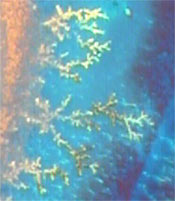A new type of memory technology could lead to thumb drives or digital-camera memory cards that store a terabyte of information--more than most hard drives hold today. The first examples of the new technology, which could also slash energy consumption by more than 99 percent, could be on the market within 18 months.
"It's a radically new technology," says Michael Kozicki, a professor of electrical engineering at the Arizona State University, whose group is one of several working on a version of the new memory. "If it really works as well as everybody thinks it could, it could genuinely revolutionize the memory and storage industry."
The new type of memory, called programmable-metallization-cell (PMC) memory, or nano-ionic memory, has been under development at the Arizona State University and at companies such as Sony and IBM. It's one of a new generation of experimental technologies that are bidding to replace hard drives, the nonvolatile "flash" memory used in portable electronics, and the dynamic random-access memory (DRAM) in personal computers. The first ionic-memory prototypes were far too slow for practical use. But recently, researchers have demonstrated that materials structured at the nanoscale could yield ionic-memory devices that are much faster. Nano-ionic memory is significantly faster than flash memory, and the speed of some experimental cells has rivaled that of DRAM, which is orders of magnitude faster than flash.
The memory could also prove easy to make. Recently, the Arizona group published work demonstrating that nano-ionic memory can be made from materials conventionally used in computer memory chips and microprocessors. That could make it easier to integrate with existing technologies, and it would mean less retooling at factories, which would appeal to manufacturers.
Another reason that ionic memory is attractive is that it uses extremely low voltages, so it could consume as little as a thousandth as much energy as flash memory. In theory, it could also achieve much higher storage densities--bits of information per unit of surface area--than current technologies can. Read

